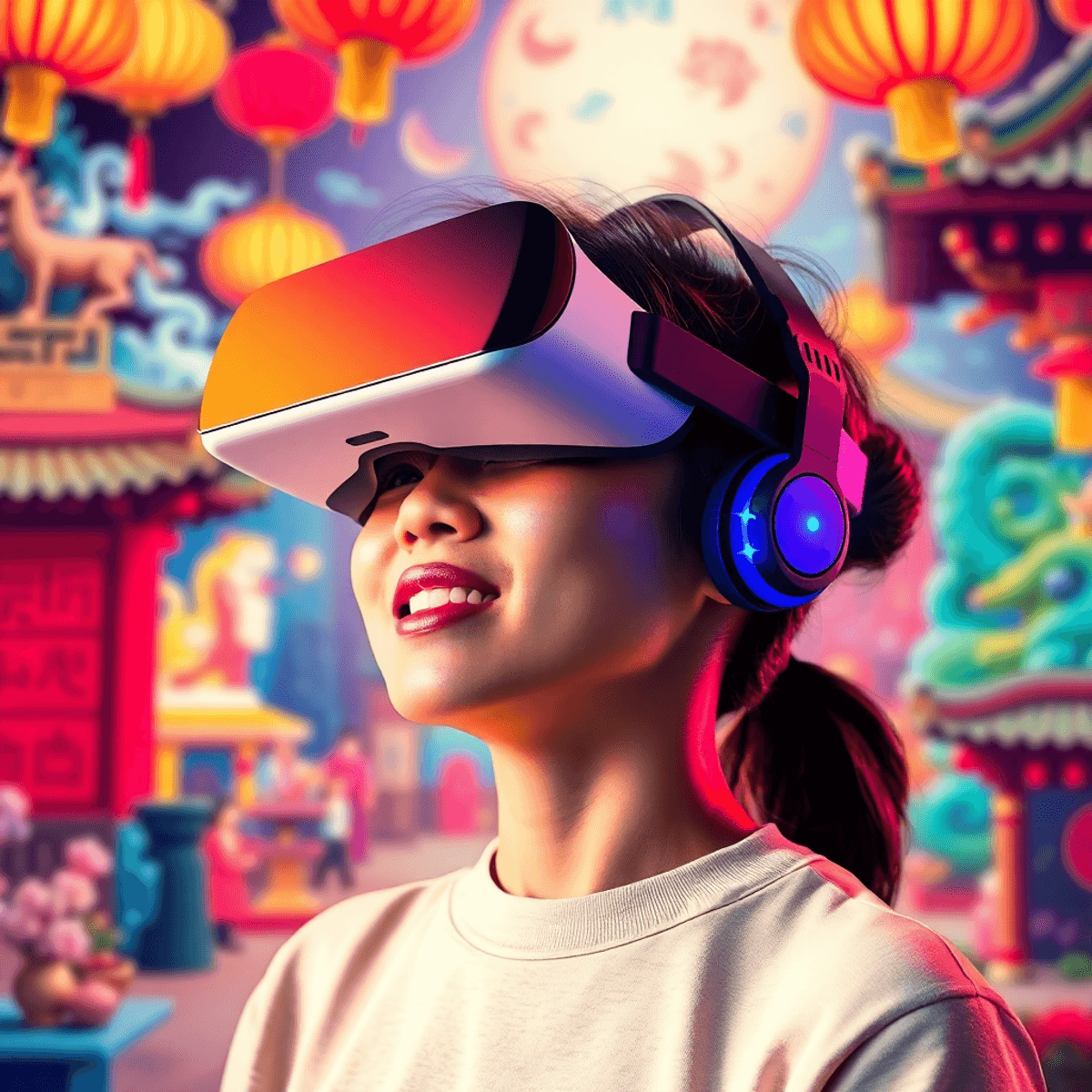
The growth of the immersive VR industry is bringing new life to China’s cultural consumption market. This rapidly expanding sector is changing the way people interact with cultural content, drawing in millions to explore history, art, and entertainment in groundbreaking ways.
Understanding this topic is crucial for grasping the changing landscape of cultural consumption in China. As technology continues to evolve, its impact on cultural heritage and consumer behavior becomes more evident. Recognizing these trends can offer valuable insights into future opportunities within the immersive VR industry, benefiting both creators and consumers.
The immersive VR industry includes a wide range of technologies and experiences created to deeply involve users in interactive ways. This industry consists of virtual reality (VR), augmented reality (AR), and mixed reality (MR) technologies, which are collectively known as extended reality (XR). XR is changing the way people interact with digital content by enabling real-time engagement that goes beyond traditional media formats.
The immersive VR landscape in China is shaped by two main factors:
By the end of 2023, the consumer market size of the immersive industry in China reached an impressive 92.7 billion yuan (approximately 12.93 billion U.S. dollars). Projections indicate that this figure will surpass 100 billion yuan by 2024. The rapid growth not only reflects technological progress but also a rising demand among consumers for innovative cultural experiences.
One interesting aspect of this expansion is how China’s red culture comes alive in VR, offering transformative experiences that connect audiences with their heritage in unprecedented ways. Moreover, there is a significant shift towards downloadable FECs (Family Entertainment Centers) which can cut costs and boost profits in the entertainment industry.
To delve deeper into these trends, the upcoming VR Arcade Game Summit scheduled for March 17-18, 2025, promises to be a crucial event in the realm of virtual reality and immersive entertainment.
Cultural heritage holds immense significance in China, serving as a bridge between the past and present. It reflects the rich history, traditions, and values of Chinese society. Immersive experiences enhance this heritage by leveraging technology to engage audiences in unprecedented ways.
The Qin Shihuang’s mausoleum, renowned for housing the Terracotta Army, serves as an exemplary case of how extended reality (XR) can bring history to life. In Xi’an, visitors don VR headsets to explore the emperor’s burial chamber, witnessing reconstructions that blend historical texts with modern creativity. This immersive XR experience allows users to perceive a “coffin floating on a sea of mercury,” creating a profound connection with China’s ancient past.
Immersive experiences are pivotal in preserving and promoting cultural heritage across various sites in China. Notable examples include:
These initiatives not only preserve historical narratives but also stimulate interest among younger generations. As immersive technology evolves, it provides innovative avenues for engaging with China’s vast cultural landscape, making history accessible and compelling.
The rise of the immersive VR industry is closely tied to technological advancements that enhance cultural consumption in China. Key innovations include:
This technology allows for the creation of highly detailed and realistic virtual environments. By accurately replicating physical spaces, 3D modeling brings historical sites and experiences to life. Visitors can explore these environments as if they were physically present.
These techniques enable seamless transitions between different views within a virtual space, enhancing immersion. Users experience a sense of presence that traditional media cannot replicate, making cultural narratives more engaging.
Advancements in hardware and software have also played a crucial role in this growth:
Enhanced tracking accuracy allows users to interact with virtual elements fluidly. This development fosters a more intuitive experience, enabling deeper engagement with the content.
The clarity offered by advanced displays contributes significantly to the immersive experience. Vivid visuals allow users to appreciate intricate details of cultural artifacts and environments.
These innovations not only enrich user experiences but also drive the vitality of China’s cultural consumption market, attracting a broader audience eager for new ways to engage with heritage and entertainment. One such avenue is the Downloadable FEC, which explores what’s possible now in the next generation of location-based virtual reality, further expanding the horizons of immersive cultural experiences.
The economic impact of the immersive industry in China is substantial, with job creation being a key component. Various roles contribute to the development and delivery of immersive experiences, including:
Insights from the 2024 White Paper on the Development of China’s Immersive Industry highlight promising growth projections across multiple sectors:
By the end of 2023, nearly 928,000 jobs were created within this thriving industry, reflecting not only its economic significance but also its role in meeting cultural needs. The government’s ongoing support for immersive projects underscores its commitment to fostering innovation while preserving cultural heritage.
Cultural consumption trends in China show a significant change in spending habits, especially among younger consumers. Here are the key points highlighting this evolution:
In the first three quarters of 2024, per capita spending on education, culture, and entertainment reached 2,295 yuan, marking a year-on-year increase of 10.1%. This rise indicates a growing willingness to invest in cultural experiences.
There is an increasing appetite for immersive experiences. Chinese consumers are actively seeking innovative forms of cultural engagement that blend technology with tradition. Virtual reality shows and extended reality (XR) projects have emerged as popular avenues for experiencing cultural heritage.
Different age groups exhibit varying levels of engagement with cultural activities. Younger generations are more inclined toward digital and interactive experiences, while older consumers retain interest in traditional forms like museums and theater.
The rapid growth of immersive experiences aligns with the broader trend of rising cultural expenditure. The immersive industry now plays a crucial role in satisfying the evolving preferences of consumers.
This landscape underscores the importance of adapting to changing consumer behaviors and embracing modern technologies to enhance cultural consumption across China.
The rise of the immersive VR industry drives the vitality of China’s cultural consumption market. Predictions highlight several advancements poised to revolutionize user experiences:
These technologies will allow users to feel sensations that mimic real-life interactions, creating deeper emotional connections with virtual environments.
BCIs may enable direct interaction between users’ thoughts and digital systems, facilitating seamless engagement in immersive experiences.
Emerging technologies will also shape cultural consumption trends beyond traditional VR/AR/XR mediums:
This innovative approach can tailor narratives based on user preferences, making experiences more personalized and engaging.
These advancements intersect with existing immersive formats, enhancing storytelling and interactivity. For instance, combining AI with VR can lead to adaptive narratives that evolve based on user choices, fostering a unique interaction each time.
Moreover, the concept of museum metaverses is gaining traction, promising to redefine cultural experiences by blending the physical and digital realms. Such innovations are part of a broader trend where consumers are encouraged to declare their independence from the ordinary through immersive technologies.
The potential for growth in this sector is immense as consumers increasingly seek novel ways to connect with culture and heritage through technology. As these future technologies emerge, they promise to redefine how audiences engage with immersive cultural experiences throughout China. For example, recent ventures like the new free-roam VR experience from UNIVRSE and Blanco y Negro illustrate how VR can bring fairy tales to life, offering unparalleled engagement. Additionally, cultural and art VR experiences are becoming essential additions to family entertainment centers, further highlighting the growing significance of immersive technology in cultural consumption.
The transformative power of immersive VR on China’s cultural landscape is undeniable. As the rise of the immersive VR industry drives vitality in China’s cultural consumption market, it becomes essential to embrace both tradition and innovation. This approach fosters sustainable growth across various sectors and enriches societal experiences.
Key considerations include:
Investing in tech-enabled solutions not only preserves rich heritage but also positions China as a leader in global cultural consumption. By merging age-old traditions with cutting-edge technology, a vibrant future awaits for both industries and society at large.


